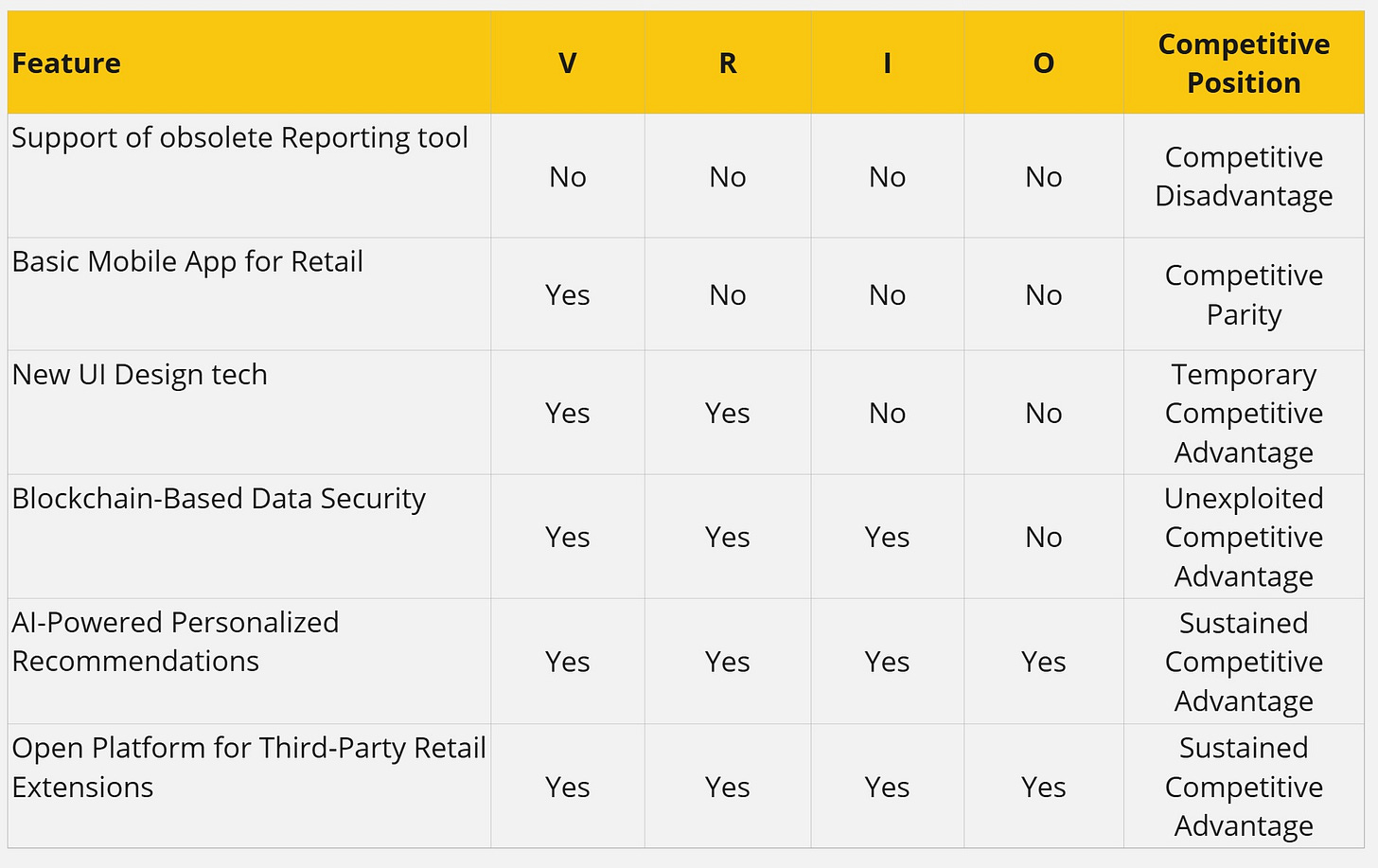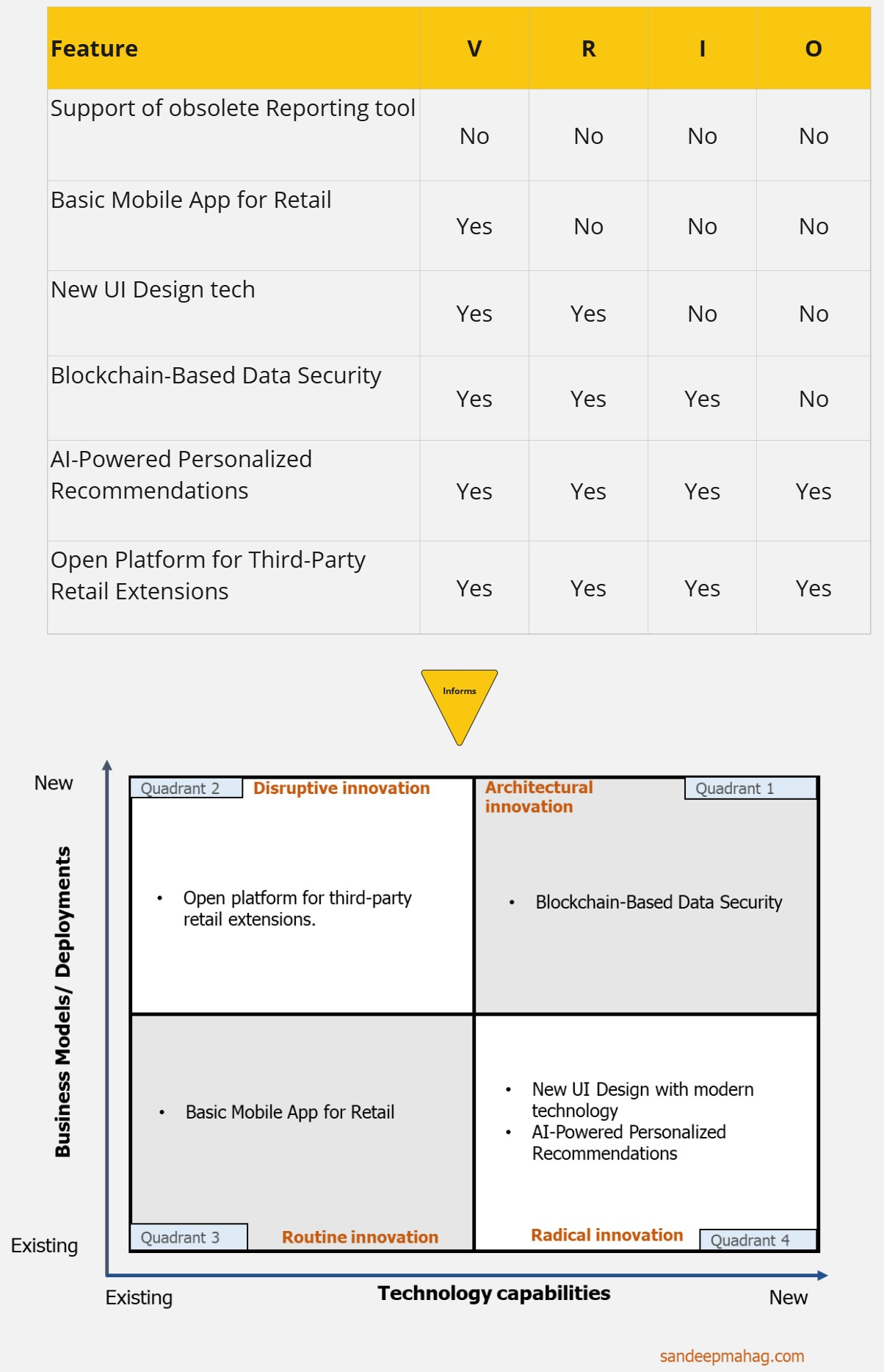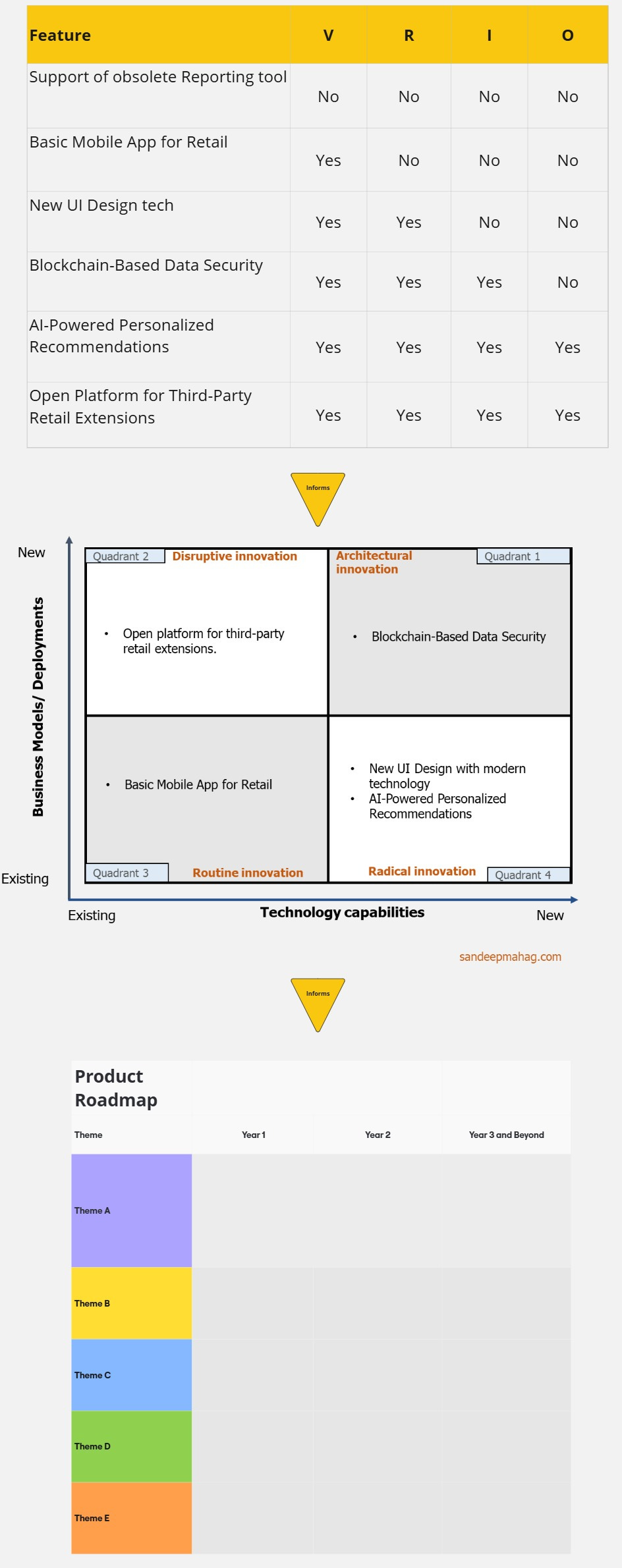Strategic Edge: Leveraging the VRIO Framework to Craft a Future-Proof Product Roadmap
Harnessing Competitive Advantage with VRIO Insights for Smarter, Long-Term Roadmap Decisions
The VRIO framework is a tool for evaluating a company's resources and capabilities to understand if they can serve as a source of sustained competitive advantage. The image illustrates a step-by-step analysis based on four key factors: Valuable, Rare, Inimitable, and Organized. Each of these criteria builds on the previous one, leading to either a competitive disadvantage, parity, or a sustainable advantage. Here's how you can implement this framework in product management decisions.
1. Valuable (V): Is the feature or capability valuable to your customers?
In practice, this means evaluating whether a new feature or product enhancement provides a solution to an essential customer pain point or creates value for the company in terms of revenue or customer satisfaction. For example, introducing a streamlined dashboard in your SaaS product that saves users time might add significant value.
How to apply it: Conduct user research, surveys, or gather feedback to understand the key pain points and align your roadmap priorities with those that solve high-impact issues. Use KPIs like user engagement, NPS (Net Promoter Score), or customer churn reduction to assess if a feature is valuable.
Result: If a feature does not provide value, it’s not worth prioritizing. If it does, move on to the next step in VRIO.
2. Rare (R): Is this feature or capability rare among your competitors?
Once you've identified a valuable feature, the next question is whether it's rare. In other words, do your competitors already offer a similar solution? If your competitors have already saturated the market with this feature, it may offer only competitive parity.
How to apply it: Perform a competitive analysis by studying the product offerings of your key competitors. Identify what they do not have or what they haven't mastered yet. For instance, if your competitors lack advanced integrations with third-party tools, developing this capability may give your product an edge.
Result: If the feature is both valuable and rare, it has the potential to give you an advantage. If not, you achieve competitive parity.
3. Inimitable (I): Is the feature difficult to imitate?
Even if your feature is valuable and rare, it can still be replicated by competitors. To gain a sustained advantage, your capability or feature should be difficult to copy. This can stem from technical complexity, proprietary technology, or even a superior user experience that is hard to replicate.
How to apply it: Assess the feasibility of competitors copying your feature. If you have proprietary algorithms, extensive AI models, or deeply integrated solutions, these are hard to replicate. Features that require significant investment in technology or expertise are less likely to be copied.
For example, a unique AI-based recommendation engine may take years for a competitor to develop.
Result: If your feature is hard to copy, you are moving toward a temporary competitive advantage.
4. Organized (O): Is your organization ready to support and capitalize on this feature?
Finally, the most valuable, rare, and inimitable features are useless if your organization is not structured to deliver them effectively. This includes having the right team, processes, infrastructure, and resources to develop, launch, and support the new feature or product.
How to apply it: Ensure that your team has the necessary skills, that your development processes can handle the feature’s complexity, and that you can bring it to market efficiently. For example, if your team lacks expertise in AI, implementing an AI-driven feature could stall unless you first organize the resources.
Also, assess your post-launch processes, like customer support, monitoring, and scalability, to ensure that the feature's value can be maintained over time.
Result: If your organization can’t support the feature, the competitive advantage might remain unused or unexploited. However, if your organization is equipped and ready, you have achieved sustained competitive advantage.
Putting VRIO into Action: Example in a SaaS Environment
Imagine you're a product manager for a CRM SaaS product, and you're evaluating a potential new feature: AI-driven customer insights.
Valuable: Does it solve a key customer pain point? Yes, it helps businesses identify trends in their customer data more efficiently, reducing the time spent on manual analysis.
Rare: Do competitors offer this? No, not many CRMs in your market have built-in AI capabilities for this level of customer insight.
Inimitable: Is it hard to replicate? Yes, because the insights rely on proprietary AI algorithms that would be difficult and time-consuming for competitors to develop.
Organized: Does your team have the necessary skills, and is the infrastructure in place? Yes, your company has invested in an AI research team, and your system architecture is built to support new AI features.
Now, let’s tie it all together and discussing how we apply the VRIO framework in a structured way for decision-making. The table below provides a visual summary of several features and how they map across the VRIO criteria:
Support of Obsolete Reporting Tool: Since this feature fails in all four categories, it’s a clear example of a competitive disadvantage.
Basic Mobile App for Retail: While it provides value, it’s a common feature and easy to replicate, resulting in competitive parity.
New UI Design Tech: This feature provides value and is rare, but is easy to replicate, leading to a temporary competitive advantage.
Blockchain-Based Data Security: Though this feature is valuable, rare, and difficult to replicate, the organization lacks the resources to fully implement it, making it an unexploited competitive advantage.
AI-Powered Personalized Recommendations and Open Platform for Third-Party Retail Extensions both meet all VRIO criteria, providing sustained competitive advantage.
Each feature can be mapped to its corresponding competitive outcome. By using this framework, product managers can prioritize features in their roadmap that not only solve customer problems but also offer long-term differentiation and advantage. This structured approach ensures the right balance between immediate needs and strategic growth.
After working through the VRIO framework in detail, it’s essential to understand how the insights derived from this framework can directly inform and enhance your product strategy. The next step is to connect these competitive insights to the Innovation Value Map (IVM), which is a strategic tool to ensure that your product roadmap has a balanced mix of innovations, from incremental to disruptive.
The diagram below demonstrates how features evaluated through the VRIO framework can be mapped to different quadrants of the Innovation Value Map:
Routine Innovations (Quadrant 3): Features like the Basic Mobile App for Retail fall here. Though they provide value, they are common across competitors and easy to replicate. They help maintain customer satisfaction but do not differentiate the product in the market.
Disruptive Innovations (Quadrant 2): Open Platform for Third-Party Retail Extensions is an example of a disruptive innovation. It introduces new business models that extend the capabilities of the SaaS product and provide sustained competitive advantage.
Architectural Innovations (Quadrant 1): Blockchain-Based Data Security fits into this quadrant. While this feature offers a high competitive advantage, the lack of organizational readiness makes it unexploited. When the organization is prepared to fully support the technology, this will move toward sustained advantage.
Radical Innovations (Quadrant 4): Features like AI-Powered Personalized Recommendations and New UI Design Tech fall into this category. They introduce significant new technological capabilities, giving the product a temporary or sustained competitive advantage depending on whether they are difficult to replicate and whether the organization can fully support them.
By mapping VRIO-evaluated features to the IVM, product managers can clearly see which areas of their product strategy require focus. Features that offer sustained competitive advantage should be prioritized for long-term market leadership, while features that maintain competitive parity might be necessary to meet immediate customer needs without offering significant differentiation.
If you're interested in learning more about how the Innovation Value Map can guide your roadmap decisions, check out my blog post on Crafting a Balanced SaaS Roadmap. This will provide deeper insights into the balance of incremental and disruptive innovations to ensure your product remains both competitive and innovative over time.
The combined insights from the VRIO framework and the Innovation Value Map (IVM) provide a strategic foundation for making informed product roadmap decisions as shown below:
By evaluating features through the VRIO framework, product managers can determine whether features offer competitive disadvantage, parity, temporary, or sustained competitive advantage. This ensures the prioritization of features that not only address customer needs but also strategically position the product in the marketplace.
Once features have been evaluated, mapping them to the IVM helps to balance innovations across routine, disruptive, architectural, and radical innovations. This strategic alignment ensures that the roadmap is well-rounded, addressing both immediate customer needs and long-term market leadership.
By leveraging both VRIO and IVM, product managers are empowered to make data-driven decisions, balancing short-term gains with long-term strategic advantages, ultimately leading to a roadmap that ensures sustained product success and differentiation in a competitive market.
Disclaimer: The views and insights presented in this blog are derived from information sourced from various public domains on the internet and the author's research on the topic. They do not reflect any proprietary information associated with the company where the author is currently employed or has been employed in the past. The content is purely informative and intended for educational purposes, with no connection to confidential or sensitive company data.







This was very informative. Very interesting way to bring VRIO into Product Management. Would start using these frameworks.